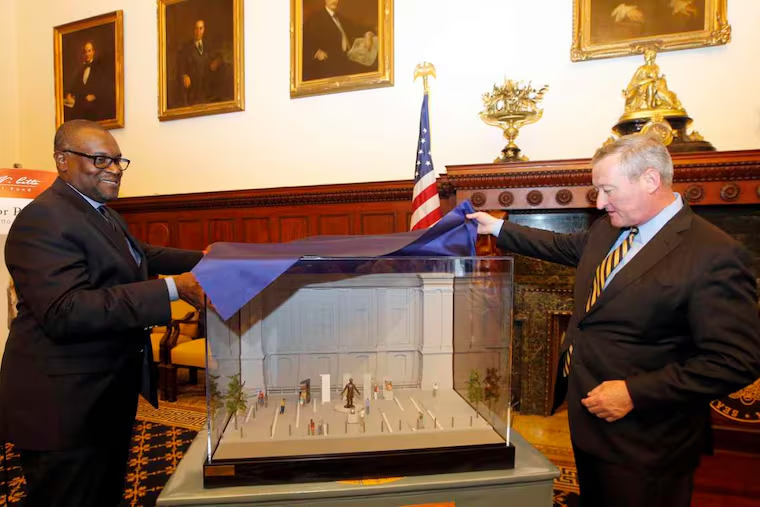Octavius Catto statue: Nineteenth-century African American leader finally to be honored
Octavius V. Catto, one of Philadelphia's greatest of Renaissance men, an activist, educator, writer, athlete, and speaker gunned down in election violence in 1871, will at last be fully honored by the city where he lived and died for his beliefs and for the color of his skin.

Octavius V. Catto, one of Philadelphia's greatest of Renaissance men, an activist, educator, writer, athlete, and speaker gunned down in election violence in 1871, will at last be fully honored by the city where he lived and died for his beliefs and for the color of his skin.
The design for a public memorial to Catto, which will grace City Hall's southern apron, will be presented to the public at a Mayor's Reception Room gathering at 11 a.m. Friday, and the artist, Branly Cadet, will be introduced to talk about his work.
The $1.5 million sculptural grouping should be completed and installed by late this year, organizers of the project said. An additional $250,000 is being raised for educational programming and maintenance. About $500,000 still must be secured in all.
It will be the first public sculpture sited at City Hall since the statue John Wanamaker, Citizen, was erected in 1923.
Cadet, based in Oakland, Calif., has produced an ambitious and allusive design focused on a 12-foot bronze statue of Catto. Arrayed behind the open-armed figure will be five granite pillars, fashioned like upturned streetcars. Catto's statue faces a stainless-steel ballot box resting on a broad table.
Incised on the granite will be excerpts from his writing: "There must come a change . . . which shall force upon this nation . . . that course which Providence seems wisely to be directing for the mutual benefit of . . . peoples."
The whole installation - called A Quest for Parity - alludes to two of Catto's most memorable public campaigns.
One was his successful effort to desegregate the city's horse-drawn streetcars in 1867 - nearly a century before similar actions fueled the civil rights movement in the South.
The other was his push to fulfill the mandate of the 15th Amendment guaranteeing the right to vote, regardless of race or "previous condition of servitude." Catto fought successfully for Pennsylvania's ratification of the amendment in 1869.
Then, as prospective black voters sought to exercise their new franchise in the racially charged, tension-filled election of Oct. 10, 1871, Catto was shot three times at Ninth and South Streets, near his home. He was only 32.
"What grabbed me the most was awareness of the continuum of the effort to cause change," said Cadet, reflecting on Catto. "How long it takes . . . people get killed, he got killed, for trying to change things."
Cadet, who has created a number of public works, perhaps most notably a monument to Adam Clayton Powell Jr. at 125th Street and Seventh Avenue in Harlem, said he felt like "a couch potato" in comparison with Catto.
"He accomplished so much in such a short time," said Cadet. "He excelled academically and intellectually. He was very engaged with his community. . . . He recruited soldiers to fight in the [Civil] War. He played competitive baseball. It's remarkable, truly remarkable."
All through the time Catto was seeking to desegregate transportation and secure the right to vote, he also taught at the city's Institute for Colored Youth, precursor of Cheyney University.
And he played baseball, organizing the first black team, the Pythian Base Ball Club. The Pythians were barred from the white Pennsylvania Baseball Association despite Catto's efforts to break the color barrier.
The Pythians then challenged white teams, and the Olympic Ball Club took them up, defeating the Pythians in a 1869 game.
"He was the Jackie Robinson and Rosa Parks of his day," said Mayor Kenney, who has pushed for the Catto memorial since his days as a councilman more than 10 years ago. "It's a fantastic story."
Yet, said Kenney, Catto's name and actions were publicly forgotten. When the mayor read about him some years ago, he was stunned.
"I was just confounded," he said. "I never heard his name, not in high school, not in college. It's a fascinating story and one that needs to be told."
The memorial, said architect James B. Straw, cochair of the Catto Memorial Fund, will have a significant educational component, which the memorial teases out with its references to trolley-car desegregation and voting rights.
"There's a story as big as the man himself," said Straw, who also remarked that Catto's story had been erased from history, resurfacing only in the last few years.
"The educational component cannot be underestimated," he said of the memorial. "This is not simply about Catto. It's about the African American community in the city. We have the opportunity to reexamine, explore, unearth the rich African American history in this community."
215-854-5594@SPSalisbury